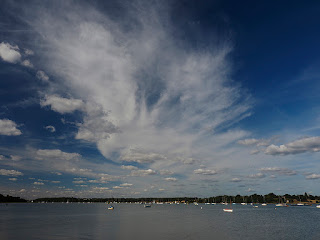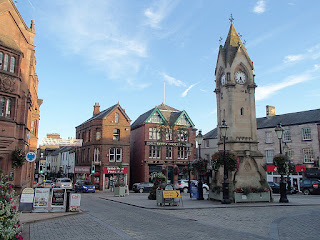 |
| Cornish coast line - credit: J |
After a grocery stop at Penzance, we arrived at our cottage in the pouring rain. Ross and Madeleine had arrived earlier, partly due to a shorter trip from London, but more likely attributable to the performance difference between a Vauxhall Corsa and a Jaguar XKR!
St Just is a small village a short distance inland of the north coast of Cornwall, not far from Land's End. It's the home of our ancestors (great-great-grandmother on my mothers's side born nearby, and some of her parents/grandparents born, married and buried here in St Just). It was the heart of the Cornish mining industry, with many derelict mines nearby, and is also Poldark country with much of the latest TV series filmed around here.
We decided it was too late to cook tea, so we hurried down the narrow lane in pouring rain to the local chippie, appropriately called Jeremy's Fish and Chips. Very nice cod and chips, followed by much chatting and catching up.
25th Sep
We were very surprised by the sunny weather this morning, so took advantage of it with a walk around the village followed by a walk along the coast. It is a very plain village, with mostly stone terrace cottages. The market square is surrounded by shops and pubs in very old granite stone buildings, with the 15th century church tower of the St Just Parish Church looming behind.
 |
| Pen-an-Gwarry - credit: S |
We then went for a short drive to the coast, from St Just through Nancherrow to the Levant mine. From there we walked back along the cliffs to Botallack, and the mine ruins there.
 |
| Crown Mines, Bottalack - credit: J |
Back home for afternoon tea and another wander around St Just, this time to Queen St where our g-g-grandparents lived. It's so hard to tell which house as some have either been pulled down/rebuilt or heavily revovated so look reasonably new. We found ourselves back in Market Square where there are 4 pubs - handy that! I tried the local Rattler cider.
 |
| Mine ruins, Levant - credit:J |
26th Sep
Today was as forecast - rain, rain and more rain. We stayed at home for the morning, but then decided to go to Penzance for lunch. It was about a 30 minutes drive in the rain across the bottom of the Cornish peninsula. Unfortunately, St Michaels Mount was obscured in the rain, and taking photographs was pointless. We wandered along some of the older streets of Penzance such as Chapel Street, with buildings dating back to the 1600s, some houses, some shops and some very quaint pubs, such as the Turks Head and the Admiral Benbow with its smuggler lurking on the roof. One of the landmark properties is the Egyptian house, built in the first half of the 19th century in the "Egyptian revivalist style" i.e. covered in gaudy Egyptian decorations.
We had a tasty lunch in a quirky cafe (the ladies toilet was totally wallpapered in leopard skin print) hoping the rain would ease off, which it didn't. An indoor activity seemed like a good idea so we went to the Penlee House Museum and Art Gallery. They have a good collection of art from the New Lynn "school" - essentially a group of artists who developed a certain style from the 1880s to the 1940s, mostly of local outdoor scenes of Cornish life. The museum area was a small but very eccentric and eclectic jumble of objects, from Pompeii mosaics, 1930s dresses and copper pots to bronze age archaeological bits, mining paraphernalia and stuffed birds.
The cafe was serving Cornish cream teas, so it would have been rude not to sample....
 |
| Mousehole - credit: S |
So the rest of the afternoon and evening was spent at home out of the rain, apart from dinner at the Kings Arms pub (nice food, slow service!) Madeleine had found a photo of the same pub from the time my ancestors lived here, so it's possible that they were customers.
27th Sep
 |
| St Ives Harbour - credit: S |
Ross and Mad met us for lunch, followed by a little more wandering. The weather still stubbornly refused to improve, so we headed homewards, this time along a more coastal route. The countryside here was a mix of bracken covered moors sprinkled with rocky outcrops and patchwork fields outlined by hedgerows. Houses and farm buildings are all greyish stone, with only the occasional place rendered in white. Quite a contrast to Scotland. One bizarre common feature in these parts is the Cabbage Tree, imported from NZ by some keen botanist in the 19th century and now almost a pest.
 |
| Landsend - credit: S |
 |
| Round house at Sennen Cove - credit:S |
The evening was spent at the cottage, watching DVDs.












































